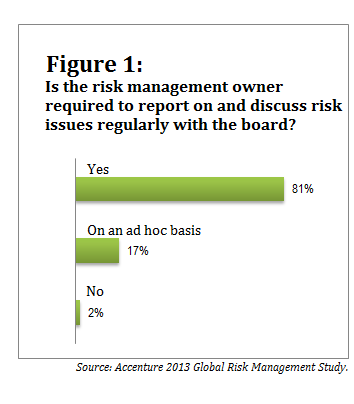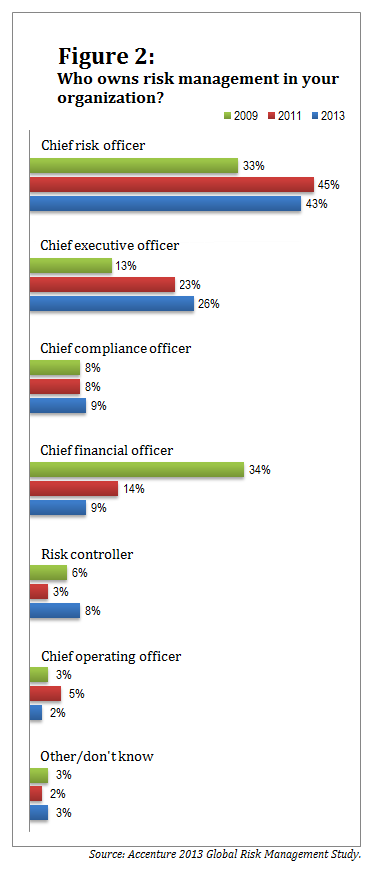As global business risks intensify, risk management is taking on an increasingly important role in companies around the world. A recent Accenture survey underlines this shift. Titled “Risk Management for an Era of Greater Uncertainty,” the study included respondents from 446 organizations around the world. Ninety-six percent said their business has an individual who functions as the chief risk officer, although in some cases without the formal title “CRO.” This is up substantially from the 78 percent of companies in Accenture's 2011 survey that had designated a chief risk officer.
Perhaps even more telling, the person responsible for risk management has the ear of these companies' senior leaders. In 81 percent of surveyed organizations, the risk management owner discusses risk issues with the board of directors on a regular basis (see Figure 1). In addition, in many organizations, risk management has moved from the responsibility of finance to fall directly within the domain of the CEO. (See Figure 2, below.)
Treasury & Risk sat down with Steve Culp, global managing director of risk management for Accenture, to talk briefly about the survey's findings.
T&R: Four years ago, risk management fell under the jurisdiction of the CFO in 34 percent of organizations. Today, that's true in only 9 percent of organizations. What has caused this shift?
Steve Culp: Due to the global financial crisis, risk management ownership has experienced major shifts. Not only was risk management elevated into an executive board-level position, but it was also reassigned from the CFO to the CRO and CEO roles. Since the first “Global Risk Management Study” in 2009, the share of organizations for which the risk owner is either the CRO or CEO has risen from 46 percent to nearly 70 percent.
In 2009, when Accenture first undertook the study, risk management was moving beyond compliance, and by 2011, it was becoming a source of competitive advantage for many businesses. Today, risk management is increasingly connected within multiple aspects of organizations, including governance and leadership structures, analytics and reporting outputs, integration and alignment with other key functions in the investment and decision-making processes, and importantly in the talent agenda.
What is really driving this trend is the increased recognition of the importance within businesses, as shown in this year's survey results.
At a time when the rules of the game are increasingly changing, businesses need risk leaders to assess where they are today and what they need to do so they can plan the course ahead.
T&R: What are the other important trends in risk management that you're seeing today?
 SC: What we see in the marketplace, and what we heard from the survey respondents, is that the role of risk management is rapidly evolving. The vast majority (98 percent) of survey respondents report an increase in the perceived importance of risk management at their organization, giving more emphasis to its integration into decision-making.
SC: What we see in the marketplace, and what we heard from the survey respondents, is that the role of risk management is rapidly evolving. The vast majority (98 percent) of survey respondents report an increase in the perceived importance of risk management at their organization, giving more emphasis to its integration into decision-making.
The study also found large gaps between the expectations of senior management for risk mitigation outcomes and their perception of their risk function's performance in those areas. For example, 95 percent identified the importance of reputation management, but only 28 percent said their risk team has provided support in that area. Managing volatility was considered important by 70 percent of respondents, but only 21 percent said the risk team contributed to such initiatives.
T&R: What risk management-related skills do companies tend to be lacking, and what they can do about it?
SC: As a consequence of the growing demands for risk management amid talent shortages, I am seeing large gaps between senior management expectations for risk mitigation outcomes and the risk function's performance—and our findings echo this. Despite 58 percent of the surveyed organizations reporting they had grown their risk management team over the last two years, many of those who participated in our study reported shortages of talent in a number of areas. For instance, 54 percent reported a shortage of candidates with the right skills to help them cope with an increasingly uncertain risk landscape. Talent shortcomings are hindering organizations' ability to successfully execute against business objectives. That is a primary obstacle in leveraging technology and data to support the risk management function.
A shortage of analytics skills in risk management compounds the problem. Sixty-one percent of our survey's respondents reported shortages in this area. Technology also plays a critical enabling role, but highly qualified talent is needed to ensure the successful application of these tools to improve risk management capabilities, and 60 percent of our respondents reported shortages of risk technologists. Those who excel tend to nurture a range of analytics skills that are specialized in the various aspects of risk management.

Complete your profile to continue reading and get FREE access to Treasury & Risk, part of your ALM digital membership.
Your access to unlimited Treasury & Risk content isn’t changing.
Once you are an ALM digital member, you’ll receive:
- Thought leadership on regulatory changes, economic trends, corporate success stories, and tactical solutions for treasurers, CFOs, risk managers, controllers, and other finance professionals
- Informative weekly newsletter featuring news, analysis, real-world case studies, and other critical content
- Educational webcasts, white papers, and ebooks from industry thought leaders
- Critical coverage of the employee benefits and financial advisory markets on our other ALM sites, PropertyCasualty360 and ThinkAdvisor
Already have an account? Sign In Now
*May exclude premium content© 2025 ALM Global, LLC, All Rights Reserved. Request academic re-use from www.copyright.com. All other uses, submit a request to [email protected]. For more information visit Asset & Logo Licensing.





